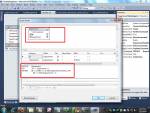Hi guys ,
I want to create manual update , delete and insert command... I am curious why ms create those line of commands:
above codes , red blod lines i don't understand , it should be simple like :
where id is the primary key.

I want to create manual update , delete and insert command... I am curious why ms create those line of commands:
VB.NET:
UPDATE Department
SET ID = ?, Department = ?
WHERE (ID = ?) [B][COLOR="red"]AND (? = 1)[/COLOR][/B] AND [COLOR="red"][B](Department IS NULL) OR[/B][/COLOR]
(ID = ?) AND (Department = ?)above codes , red blod lines i don't understand , it should be simple like :
VB.NET:
UPDATE Department
SET ID = ?, Department = ?
WHERE (ID = ?) AND (Department = ?)
